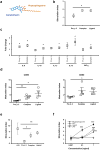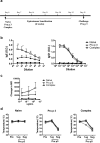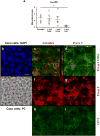Mechanisms underlying induction of allergic sensitization by Pru p 3
- PMID: 28618148
- PMCID: PMC5659917
- DOI: 10.1111/cea.12962
Mechanisms underlying induction of allergic sensitization by Pru p 3
Abstract
Background: Recently, the nature of the lipid-ligand of Pru p 3, one of the most common plant food allergens in southern Europe, has been identified as a derivative of the alkaloid camptothecin bound to phytosphingosine. However, the origin of its immunological activity is still unknown.
Objective: We sought to evaluate the role of the Pru p 3 lipid-ligand in the immunogenic activity of Pru p 3.
Methods: In vitro cultures of different cell types (monocyte-derived dendritic cells [moDCs], PBMCs [peripheral blood mononuclear cells] and epithelial and iNKT-hybridoma cell lines) have been used to determine the immunological capacity of the ligand, by measuring cell proliferation, maturation markers and cytokine production. To study the capacity of the lipid-ligand to promote sensitization to Pru p 3 in vivo, a mouse model of anaphylaxis to peach has been produced and changes in the humoral and basophil responses have been analysed.
Results: The lipid-ligand of Pru p 3 induced maturation of moDCsc and proliferation of PBMCs. Its immunological activity resided in the phytosphingosine tail of the ligand. The adjuvant activity of the ligand was also confirmed in vivo, where the complex of Pru p 3-ligand induced higher levels of IgE than Pru p 3 alone. The immunological capacity of the Pru p 3 ligand was mediated by CD1d, as maturation of moDCs was inhibited by anti-CD1d antibodies and Pru p 3-ligand co-localized with CD1d on epithelial cells. Finally, Pru p 3-ligand presented by CD1d was able to interact with iNKTs.
Conclusions and clinical relevance: The Pru p 3 lipid-ligand could act as an adjuvant to promote sensitization to Pru p 3, through its recognition by CD1d receptors. This intrinsic adjuvant activity of the accompanying lipid cargo could be a general essential feature of the mechanism underlying the phenomenon of allergenicity.
Keywords: iNKT; CD1d; Pru p 3; lipid transfer proteins; peach allergy.
© 2017 John Wiley & Sons Ltd.
Conflict of interest statement
The authors declare that they have no conflicts of interest.
Figures





Similar articles
-
Immunological Changes Induced in Peach Allergy Patients with Systemic Reactions by Pru p 3 Sublingual Immunotherapy.Mol Nutr Food Res. 2018 Feb;62(3). doi: 10.1002/mnfr.201700669. Epub 2018 Jan 8. Mol Nutr Food Res. 2018. PMID: 29105313 Clinical Trial.
-
Impact of glutathione on the allergenicity of the peach lipid transfer protein Pru p 3.J Investig Allergol Clin Immunol. 2015;25(1):47-54. J Investig Allergol Clin Immunol. 2015. PMID: 25898694
-
The clinical and immunological effects of Pru p 3 sublingual immunotherapy on peach and peanut allergy in patients with systemic reactions.Clin Exp Allergy. 2017 Mar;47(3):339-350. doi: 10.1111/cea.12901. Clin Exp Allergy. 2017. PMID: 28160513 Clinical Trial.
-
Almond allergens: update and perspective on identification and characterization.J Sci Food Agric. 2020 Oct;100(13):4657-4663. doi: 10.1002/jsfa.10417. Epub 2020 Apr 29. J Sci Food Agric. 2020. PMID: 32270879 Review.
-
Endogenous lipid antigens for invariant natural killer T cells hold the reins in adipose tissue homeostasis.Immunology. 2018 Feb;153(2):179-189. doi: 10.1111/imm.12839. Epub 2017 Oct 26. Immunology. 2018. PMID: 28898395 Free PMC article. Review.
Cited by
-
Where's the Beef? Understanding Allergic Responses to Red Meat in Alpha-Gal Syndrome.J Immunol. 2022 Jan 15;208(2):267-277. doi: 10.4049/jimmunol.2100712. J Immunol. 2022. PMID: 35017216 Free PMC article. Review.
-
Glycolipid-mediated basophil activation in alpha-gal allergy.J Allergy Clin Immunol. 2020 Aug;146(2):450-452. doi: 10.1016/j.jaci.2020.02.006. Epub 2020 Feb 20. J Allergy Clin Immunol. 2020. PMID: 32088306 Free PMC article.
-
Investigation of Sensitization Potential of the Soybean Allergen Gly m 4 by Using Caco-2/Immune Cells Co-Culture Model.Nutrients. 2021 Jun 16;13(6):2058. doi: 10.3390/nu13062058. Nutrients. 2021. PMID: 34208504 Free PMC article.
-
Allergens and their associated small molecule ligands-their dual role in sensitization.Allergy. 2021 Aug;76(8):2367-2382. doi: 10.1111/all.14861. Epub 2021 May 2. Allergy. 2021. PMID: 33866585 Free PMC article. Review.
-
The Role of Sphingolipids in Allergic Disorders.Front Allergy. 2021 Jun 14;2:675557. doi: 10.3389/falgy.2021.675557. eCollection 2021. Front Allergy. 2021. PMID: 35386967 Free PMC article. Review.
References
-
- Pawankar R, Canonica GW, Holgate ST, Lockey RF. Allergic diseases and asthma: a major global health concern. Current opinion in allergy and clinical immunology. 2012;12:39–41. - PubMed
-
- Hedlin G, et al. Problematic severe asthma in children, not one problem but many: a GA2LEN initiative. The European respiratory journal. 2010;36:196–201. - PubMed
-
- Muraro A, et al. The management of the allergic child at school: EAACI/GA2LEN Task Force on the allergic child at school. Allergy. 2010;65:681–689. - PubMed
-
- Fox M, et al. Health sector costs of self-reported food allergy in Europe: a patient-based cost of illness study. European journal of public health. 2013;23:757–762. - PubMed
MeSH terms
Substances
Grants and funding
LinkOut - more resources
Full Text Sources
Other Literature Sources
Medical

